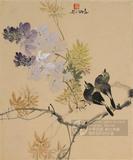清王翬溪山村落 卷
推薦分享
資源連結
連結到原始資料 (您即將開啟新視窗離開本站)後設資料
- 資料識別:
- 故畫001046N000000000
- 資料類型:
- 類型:繪畫
- 型式:靜態圖像
- 著作者:
- 王翬
- 主題與關鍵字:
- 楊柳 冬景(雪景) 騾.驢 傢俱(屏風) 百姓 耕織漁獵 竹 山徑 籬笆、圍牆 芭蕉 寒林.枯樹 房舍 農夫 橋 松 溪澗、湍泉 高士(士人、隱士)
- 出版者:
- 數位化執行單位:國立故宮博物院
- 日期:
- 清聖祖康熙五十六年(1717)
- 格式:
- 本幅 51.4x174.9公分、隔水一 14公分、裱綾一 14.1公分、引首 28.8x106.2公分、裱綾二 14.4公分、隔水二 14.3公分、拖尾 51.5x34.6公分
- 關聯:
- 石渠寶笈續編(御書房),第四冊,頁2092&*故宮書畫錄(卷四),第二冊,頁263&*故宮書畫圖錄,第二十冊,頁183-184&* 王翬(西元一六三二-一七一七年),江蘇常熟人,字石谷。自幼善畫,青年時得拜王鑑、王時敏為師,二人盡傳所學,又常常帶他參觀各地收藏,藉此揣摩古人畫技,因此他能夠筆參古今,貌合南北,畫技精熟,為清初四大家之一。 此圖成於康熙丁酉,是八十六歲臨終前數月的作品。畫上自題皴染布格,差近巨然,而荒寒蕭颯又彷彿王維的雪景。觀其筆墨,雖筆蹤顫動,不若盛年,而下筆老辣,意境荒寒,確另有盛年異趣之處。 &* Wang Hui (style name Shih-ku) was a native of Ch’ang-shu, Kiangsu. As a child he was skilled in painting, and as a youth he came to the attention of Wang Chien and Wang Shih-min, who took him in as a student and thoroughly trained him. Wang Hui often accompanied them on trips to see various painting collections, which he examined and copied carefully, learning the styles of the ancient masters. Thus, he became accomplished in both old and new styles, and united southern and northern styles in a refined and polished fashion. Wang Hui is known as one of the Four Wangs of the early Ch’ing dynasty. This work was executed in 1717, when Wang Hui was 85-years-old, just a few months before his death. In his inscription on the work, Wang Hui says that the rock-texturing methods, coloring and composition were after the 10th-century painter Chü-jan, while the cold and desolate air emulated Wang Wei’s snowscape The Wang-ch’uan Villa in Snow. Wang Hui’s tremulous brushwork here is not as firm as it used to be in his best years, but his technical skills are austerely mature with decisiveness and power, and the desolate cold he has portrayed here penetrates with an effectiveness that had rarely achieved before.
- 管理權:
- 國立故宮博物院
授權聯絡窗口
- 國立故宮博物院圖像授權、出版授權、影音資料授權-申請流程說明
http://www.npm.gov.tw/zh-TW/Article.aspx?sNo=03003061






